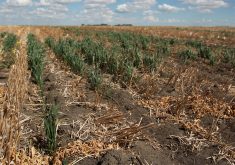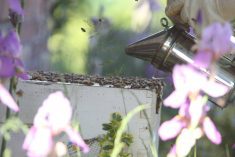Crop types that require less water can reduce growers’ exposure to below normal precipitation and runoff
Soil moisture and precipitation in Alberta are far from ideal for field crops and even irrigated land had challenges in the last growing season — a situation that had many producers talking options during the Ag Connections conference in Medicine Hat in November.
“This is the first year that we’ve ever talked about water shutoffs during the season,” said Brian Slenders, who runs a 13-quarter section mixed farm with corn, wheat and alfalfa seed under pivots.
Early fall shutoffs aren’t rare, said Slenders, who runs his irrigation system off the Eastern Irrigation District network, but conditions startled producers in July because of a dry spring and unusually low mountain runoff.
Read Also

Farmers asked to keep an eye out for space junk
Farmers and landowners east of Saskatoon are asked to watch for possible debris in their fields after the re-entry of a satellite in late September.
“It turned out we didn’t turn it off but we certainly could of. We were lucky in that respect,” he said, noting a late July heavy rainfall along the Eastern Slopes was enough to keep the pivots turning.
As for next season, Slenders said he is preparing to use crops that require less water if the same conditions appear in 2024.
“Things like a barley crop versus corn, a green-feed crop versus potatoes, beets or alfalfa. Something we can turn the water off if we have to,” he said. “Some of these high-value crops that only produce at the end are the most at risk. If all you grow is corn and potatoes, you could potentially be in trouble.”
Slenders said he’ll be watching the snowpack levels over winter while trying to find ways to keep as much moisture in the ground as possible during the next few months but it’s going to be difficult to make seeding decisions before the usual heavy rainfall month of May.
“Plan, plan, plan,” said Slenders.
Irrigation technology specialist and Lethbridge College professor Willemijn Appels said detailed tracking of moisture conditions throughout the season will be key in getting through another season of low river levels with little precipitation.
“You can’t just willy-nilly put on an inch every week. You have to be more strategic about it and determine what’s good and bad soil moisture and see if you can spread out the timing of applications,” said Appels.
One of the best but most underrated tests on irrigated land are hand tests using a soil probe, she said.
“That’s still a relevant method, as long as you do it consistently,” she said.
Another underused tool is the Alberta Irrigation Management Model, which is available online. It advises producers on water scheduling decisions and is free to download, said Appels.
“You can see how much your crop has used in terms of water since seeding over a season based on weather conditions and getting a feel for that to make sure you are getting your requirements, especially in the periods of growth where it matters most,” she said.
This past year was a good one for many farms with irrigation, as long as water management was regimented, due to the consistent warm weather that wasn’t too extreme, said Appels.
“What I’ve heard is (irrigators) were really worried they didn’t put on as much water as they’d like but they still had good crops. That would indicate that there is still some wiggle room,” she said.
To get the most out of that wiggle room will require revisiting the irrigation manual, ensuring that techniques for maximum efficiency at the right points in development, “instead of saying my neighbour is irrigating, I should be too,” said Appels.
As for products to help retain soil moisture, Roxanne Doerksen of TRAD Worm Industries said her business’s vermicast products are a natural amendment that can help moisture levels.
“Anything that is carbon-based, we will process and feed to worms,” said Doerksen, who presented at the Ag Connections conference as part of an innovation in southeast Alberta panel discussion.
“It produces a casting, which is biologically diverse, and we can use it as an amendment.”
While Doerksen said there will be no magic pill to deal with the persistent moisture-deficiency issues, vermicast products act as a sponge when there is rainfall.
“It absorbs moisture when it comes in and it slowly releases it back,” she said. “Because biology wants to self-sustain and we want to have nutrient cycling and we want to be able to buffer, the healthier our soil is, the more buffering it can do.”
According to the latest agricultural moisture situation update from the Alberta government, a rebound in moisture levels in October likely wasn’t enough.
“This translates to total moisture deficits in at least the 300 to 400 millimetre range, which in the case of the Special Areas and adjacent parts of the southern region, translates to a full year of lost moisture in the last three years. Many parts of Alberta are long due a wet cycle. Multiple years of below-normal moisture regimes are taking their toll,” according to the update.


















